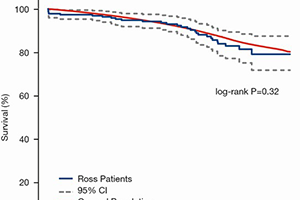Long-term outcomes of the Ross procedure in adults
Abstract
Background: The optimal aortic valve replacement for young and middle-aged adults remains elusive. Although several high-volume international centers and surgeons have demonstrated excellent long-term results with the pulmonary autograft (Ross procedure) in adult patients, current guidelines from the United States do not favor this technique. We evaluated long-term clinical and echocardiographic outcomes of adult patients undergoing the Ross procedure at our center.
Methods: A retrospective review of 225 consecutive adult patients undergoing the Ross procedure was completed. Kaplan-Meier analysis was performed to evaluate overall survival, which was then compared to an age- and sex-matched general population with the log-rank test. Accounting for death as a competing hazard, the cumulative incidence of reintervention and autograft or homograft dysfunction were estimated over the long-term.
Results: Mean age was 42±11 years, and 62 (28%) patients were at least 50 years old. A bicuspid aortic valve was present in 179 (80%) patients. The most common indications for surgery were aortic insufficiency (n=94, 43%), aortic stenosis (n=81, 36%), and mixed etiology (n=46, 21%). In-hospital mortality was 0.9%. Overall survival (with 95% confidence intervals) at 1-, 10- and 20-year was 97.8% (95.9–99.7%), 94.2% (91.0–97.4%), and 81.3% (74.8–88.3%), respectively. Overall survival approximated that of the general population (log-rank P=0.32). The cumulative incidence (with 95% confidence intervals) of any autograft or homograft reintervention at 10-, 15-, and 20-year was 16% (12–20%), 28% (21–35%), and 45% (36–54%), respectively.
Conclusions: The Ross procedure restores a normal life expectancy to young and middle-aged adults with severe aortic valve disease. The need for reintervention increases steadily during the second decade after the Ross procedure, but less than half of patients require any reintervention for up to 20-year.
Cover






